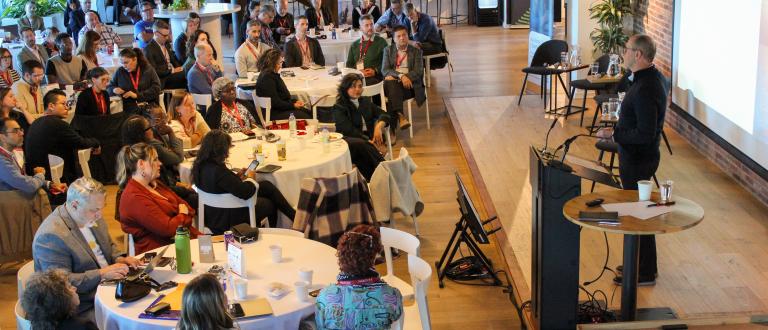The recent election in the United States galvanized an international conversation on the concept of democracy and the democratic process. It got us thinking about how opaque and often lacking in democracy philanthropy can be internationally and here in Canada.
Those with significant wealth and capacity to make major gifts are often afforded the greatest influence in shaping the impact their gifts will create and in turn shaping broader society through their philanthropy; where those whose gifts may be in the hundreds of dollars or less are not often afforded the opportunity to influence the impact of their gift. It feels like each dollar is a vote - and the more dollars the more votes, and thus the more influence you have as a donor - this is very similar to the democratic system in the US, here in Canada and frankly around the world. Those with money buy influence, however in large part the donors with the greatest influence and capacity don't share the diversity of the broader Canadian public. Are we missing the important nuances in philanthropy? And how do we ensure the interests of the very few don't terminate the interests of the many who have comparatively smaller means?
Donors through their support can and do influence the direction of charitable organizations. Does this mean that the larger the donor, the bigger the influence?
Many nonprofit organizations across Canada pride themselves on their deep roots in philanthropy. Stories of transformational philanthropy and great generosity inspire staff, volunteers and other philanthropists alike. Many of these donors are truly altruistic and have clearly had a beneficial impact on their communities by supporting hospitals, universities, churches or arts and cultural institutions. However, when taken as a whole and examined with a lens for diversity and inclusion, another story emerges: charities that have attracted such donors, or the charities these donors choose to support, also shaped our society to advance some causes or initiatives more than others.
Organizations with the greatest capacity to steward and recognize donors (e.g., the ability to put a donor’s name on a building) seem to fare much better than organizations whose mission is less capital intensive or not likely to yield much recognition. And forgive us for being cynical, we don’t suggest that donors are homogenous, nor do they only donate for recognition. An example to illustrate our point: it is clear that Black people and Black communities in Canada have far less social capital than other people and communities, namely white. Accordingly, influence acquired through philanthropic investment in Black communities and Black-serving charities would not be particularly valuable. And the proof is there - for every 100 dollars donated to a charitable organization in Canada, as little as seven cents go toward supporting Black charities, concludes a new first-of-its kind study of the country's philanthropic sector and its impact on Black communities.
In capital campaign fundraising it is not uncommon for organizations to solicit the feedback of their most loyal benefactors before embarking on major campaigns. One could presume that if new projects are not looked on favourably by donors, they don’t get the green light, regardless of their merit. So is it possible that the way we do philanthropy gives major and mega donors influence over the direction of the organization - directly or indirectly?
Should smaller donors have a say?
In democratic societies - majority wins. So perhaps it is not unreasonable to expect that those who would naturally have more contact with leadership and more resources (financial, networks etc.) will be afforded more influence over the use of funds. However, an argument can be made that those who give less - such as annual fund donors, for example - give a greater proportion of their income and mostly direct their giving to the “keep the lights on” projects (e.g. undesignated gifts that can be used for overhead expenses). In a way, they have the most direct impact on organizations, yet they have little or no influence over the direction of organizations and little or no access to leadership. Could we reimagine a philanthropic model where even smaller donors receive the praise and engagement major donors do?
Is there evidence that mega donors have shaped/influenced society through their philanthropy?
It’s worth repeating that a vast majority of donors are truly altruistic and come from a place of wanting to improve society. However, due to their relative homogeneity and their privilege, they are likely to view society from a certain lens and therefore attribute importance to some causes over others, and some projects over others. It is not hard to find examples of causes or initiatives that have benefitted from the support of a homogenous group of donors while other causes have struggled to appeal to the same groups of donors. It is not due to malice or overt intentions but rather due to the overwhelming homogeneity of major donors and board members in Canadian charities. Many large organizations have strong history and established endowments directed at particular initiatives which may no longer be a focus or need for the organization. Perhaps we should reimagine a philanthropic model where endowments are not meant to be permanent and project importance is meant to be revisited every decade or so?
It is important to acknowledge the generosity of racialized communities in giving. For example, black donors often give some of the highest percentages of their incomes to charity compared to other racial groups, but they are not recognized as the conventional face of philanthropy. Similarly, affluent Canadian women donate a higher proportion of their investable assets to charity than men. Women are a key demographic that fundraisers should be including in their strategies. However, 40% of women working at major charities say there is less of an emphasis on soliciting gifts from women, and only 33% of women working at major charities believe that wealthy female donors are given the same respect as their male counterparts.
Moving forward
If a political party was considering legislation that would fundamentally impact who could access higher education, it would be expected that they would consult with scholars, university and college students, prospective students, and other relevant stakeholders. The same should be true of charities - and unfortunately it is often those with the least social capital and the beneficiaries of funds raised that are forgotten in the planning process, or given the least influence in strategy development. A few examples for how charities can meaningfully share power with stakeholders least represented in traditional Canadian philanthropy:
- Profile and position beneficiaries of funds from an asset-based lens (even when their stories are anonymized), in the same way donors are positioned - focusing on their strengths and aspirations and minimizing the focus on the adversity they have faced.
- Avoid at all costs using community as unpaid consultants. The Black Lives Matter and Land Back movements have caused a renewed interest from mainstream organizations in supporting racial justice and inclusivity. Do not reach out to the BIPOC staff in your organization, or leadership volunteers to ‘pick their brain’ or ask them to lead an equity, diversity and inclusion strategy. This work has value, represents real labour even if the experience someone is bringing forward is lived v. professional; and prioritize and pay for it this work.
- Think about the energy and intention that goes into establishing young philanthropist groups, or engaging volunteers and community to help ideate the next ice-bucket fundraising challenge. Take that equal energy and passion and engage volunteers and community who give their time and talents to your organization, and engage them in shaping programming and investment areas for the funds raised.
We suggest that charities have a responsibility to ensure their fundraising practices are democratic and inclusive. The world is changing, and so is philanthropy.
Guest contributions represent the personal opinions and insights of the authors and may not reflect the views or opinions of Imagine Canada.
Authors
Tanya Hannah Rumble, CFRE, MFA-P™
Tanya Hannah Rumble, CFRE is a fundraising leader who has raised millions for some of Canada's largest charities. Tanya is passionate about equity, diversity and inclusion; and power and privilege and how these intersect with philanthropy. Tanya holds an Honours Bachelor of Arts in Political Science from McMaster, earned a Graduate Certificate in Marketing Communications at NYU; she is also a graduate of the AFP Inclusion and Philanthropy Fellowship, and DiverseCity Fellowship. Tanya is a new mom, a voracious consumer of podcasts, and a baking enthusiast. Tanya gratefully acknowledges the traditional territories of the Mississauga and Haudenosaunee nations, whose traditional territory she lives and works with her husband and young son.
Mariya Yurukova, MBA, CFRE
Mariya is an experienced fundraiser and thought leader in the nonprofit sector. With over fifteen years of experience in fundraising, Mariya has raised more than $20 million for various organizations, working on gifts ranging from millions to direct marketing campaigns for first time donors. Mariya is an active voice and advocate for diversity and inclusion in the nonprofit sector, with publications in Hilborn Charity E-News, Advancing Philanthropy, CASE Currents Magazine and many more. As a first generation immigrant woman and part of an interracial family, Mariya is keenly aware of systemic inequities in the nonprofit sector and works towards advancing social justice causes while acknowledging her own privilege.



